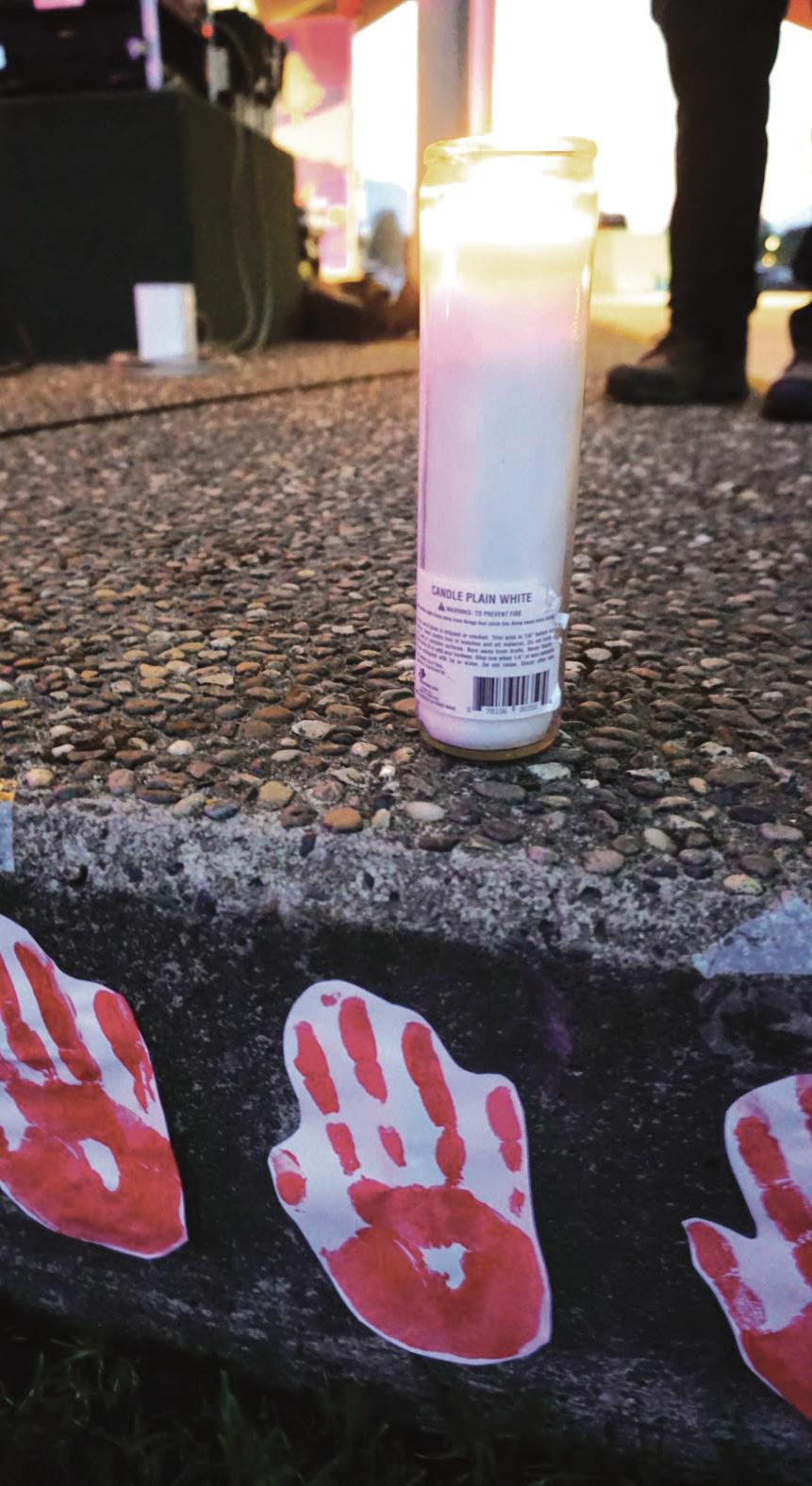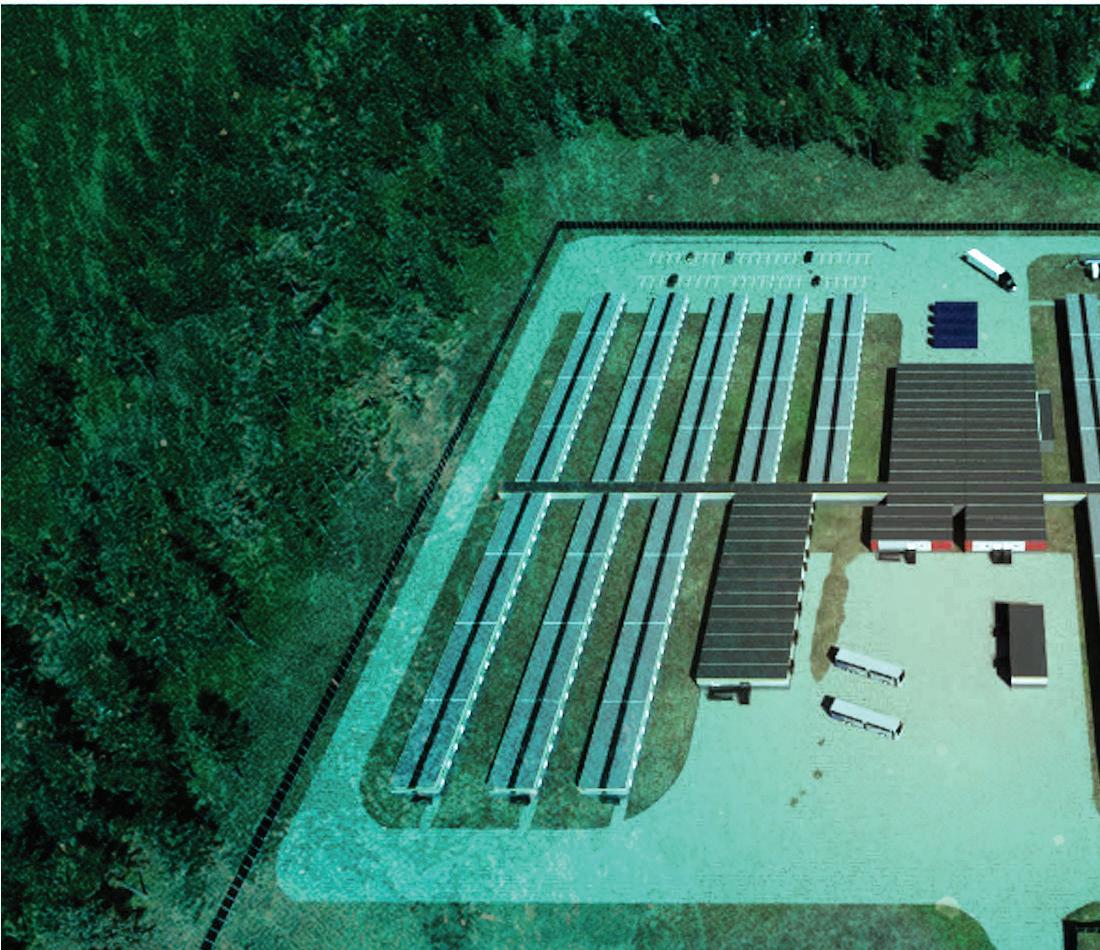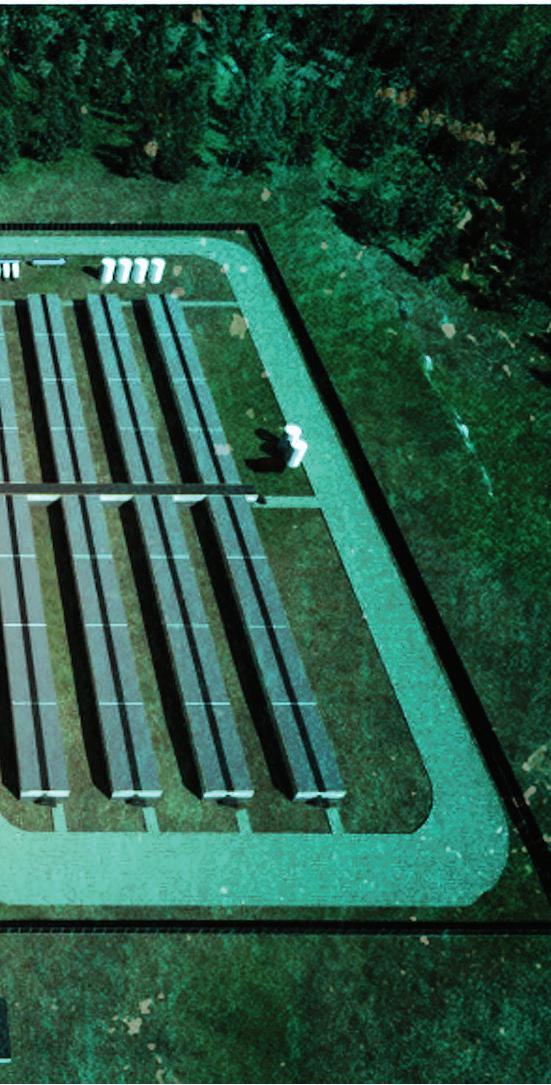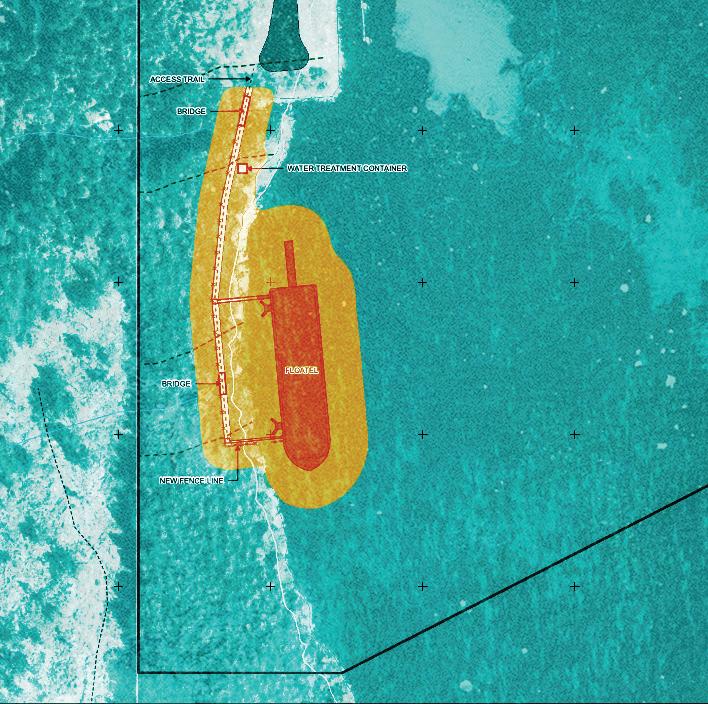
17 minute read
at some to say
JENNIFER THUNCHER / SQUAMISH CHIEF
aime Williams, whose ancestral name is Sewinchelwut, worries about what the FortisBC and Woodfibre LNG work camps planned for Squamish could mean for the safety of her and her children.
Advertisement
In order to house the hundreds of construction workers required to build the planned Woodfibre LNG export facility, the company is asking the provincial Environmental Assessment Office (EAO) for an amendment to its original plans to use a temporary, self-contained floating worker accommodation (also known as a “floatel”) located on Howe Sound.
FortisBC is asking the EAO to expand the footprint of its temporary accommodation for workers that will build the associated Eagle Mountain – Woodfibre Gas Pipeline Project. FortisBC expects there to be 600 workers at the peak of construction, expected for the summers of 2024 and 2025. The company also estimates there will be an additional 40 local workers onsite at those times.
The FortisBC workers would be housed in a temporary camp on three hectares of private land located behind the Quest University lands at the end of the Mamquam and Powerhouse Springs Forest Service Roads.
Williams, who was raised in Squamish, says the number of workers expected is too many.
She said as much as the companies may say the workers will be in self-contained camps, they will likely want to come to town on their off hours.
Williams said Squamish only has a few pubs, so that is likely where workers will end up.
“I have two beautiful daughters and a son, and that’s my concern,” she says.
“Where all these man camps are in other parts of B.C. and other parts of the world, it’s the Indigenous women who live near those man camps that get victimized.”
She added that she doesn’t feel the RCMP would “do anything about it,” if the camps did lead to violence against Indigenous folks.
In the fall, Williams demonstrated at a Woodfibre LNG open house held at Howe Sound Secondary. A plain-clothed RCMP officer intervened.
My Sea to Sky videotaped the interaction.
While the officer only uses his voice and body language with Williams, she said it felt intimidating.
“I was afraid of him,” she said.
Asked what the companies could do to mitigate her fear of the workers, Williams said history teaches her not to trust any such promises.
“If they could, how come they couldn’t do it already?” she said.
She said if the “man camps” come to Squamish and the surrounding area, she won’t feel safe walking the streets at night and she won’t feel safe going into the local pub for a drink on a Friday night after the end of a busy week as a teaching assistant.
She says she isn’t vilifying individual workers, but said these camps have a culture and systemic racism comes along with that.
What Studies Say
According to the federal government, as of April 2022, there were 470 major resource projects under construction or planned for the period of 2022 through 2032 in Canada, representing $520 billion in potential capital investment.
Numerous studies back up Williams’ fear of the influx of workers expected in town.
In December, the House of Commons Standing Committee on the Status of Women (FEWO) released a report Responding to the Calls for Justice: Addressing Violence Against Indigenous Women and Girls in the Context of Resource Development Projects, that confirmed the dangers to vulnerable populations.
“[R]esource development companies must be held accountable for their projects’ impacts on Indigenous lands, waters, and communities,” the report read. “This can be done by requiring companies to establish workplace safety plans and policies, track and report incidents of gender-based violence, educate workers about gender-based and sexual violence, cultural safety, and the effects of colonization on Indigenous peoples, as well as increase and ensure Indigenous women’s participation in all aspects of resource development projects.”
It echoes others, like the 2017 study by The Firelight Group with Lake Babine Nation and Nak’azdli Whut’en, which concluded, among other things, that “the model of the temporary industrial camp requires a mobile workforce that is disconnected from the region, and this reinforces and recreates historical patterns of violence against Indigenous women.”
A spokesperson for the Sk_wx_wú7mesh Úxwumixw (Squamish Nation) declined to comment for this story.
“I would refer your questions to Woodfibre LNG as they’re responsible for operating these camps. The Squamish Nation is only tasked with being an environmental regulator on the project,” the spokesperson said.
‘ADVERSE CUMULATIVE EFFECTS’
Local environmental organization My Sea to Sky, which has fought Woodfibre LNG coming to Squamish for about nine years, argues work camps for resource extraction projects can have significant and often unanticipated impacts on nearby communities.
“Woodfibre LNG and FortisBC have failed to adequately consider many of these impacts for their proposed work camps, and the adverse cumulative effects of two workcamps for up to [about] 1,250 temporary workers has never been assessed,” writes executive director Tracey Saxby in an email.
The original proposal from FortisBC was a work camp for 150 to 250 workers, located on the west side of the Squamish River, close to the Woodfibre site.
“Now they’re proposing a work camp for [about 600] workers in the community of Squamish—that’s over two to four times bigger—and locating a work camp in our community changes the risks for people that live in our community.”
Saxby points to studies done during the construction that show industrial projects with large numbers of temporary workers have resulted in increased:
» Workplace accidents
» Substance abuse and misuse
» Traffic accidents and collisions
» Violent crime, including sexual assault and sexualized violence, domestic violence and violence against Indigenous women and children
» Rates of prostitution
» Demands on hospitals, counselling, police, and ambulance services, which results in reduced service capacity for residents
» Risk of COVID-19 outbreaks
» Waste disposal issues


Asked what mitigation the companies could do to satisfy the organization’s concerns, Saxby said “mitigation” is the wrong word.
“We need to talk about how to prevent possible harm. If one person is sexually assaulted due to these work camps, that is one too many,” she says.
“FortisBC and Woodfibre LNG have failed to adequately consult the community, and they have failed to plan. The human rights and safety of everyone that lives in Squamish and nearby communities are being put at risk.”
Saxby also says there is no certainty that Woodfibre LNG and FortisBC will pay for the increased burden on local services, such as policing.
The District of Squamish has allocated $470,000 for increased policing expenses, but there is no agreement in place with Woodfibre LNG and FortisBC to cover these costs.
My Sea to Sky has asked the District to lobby to Minister of Environment and Climate Change George Heyman and Minister of Energy, Mines and Low Carbon Innovation Josie Osborne, on behalf of the general public, to ensure oversight and evaluation of the cumulative effects of work camps on Squamish.
The District said that, “where possible, mayors past and present have taken opportunities, when they have presented themselves, to lobby on this topic. These have been in various forms—at UBCM meetings, in Victoria, and through correspondence.”
Respect For Labourers
The tone of some of the discourse in town around work camps can sometimes raise the eyebrows of those with careers in the industry. For example, the language of wanting workers not to leave their compounds to venture into town, for example, can echo elitist or classist fears of blue-collar labourers.
Squamish Mayor Armand Hurford says safety for all of the community is his top priority.
“I have the Missing and Murdered Indigenous Women’s Recommendations open on my laptop at all times,” he says.
He also wants to be very careful around the discourse with the issue so that it is not a vilification of construction workers or labourers.
“You have to be very intentional and be able to listen to the nuance and the phrasing and the messaging. It’s really hard to speak about, but it’s absolutely imperative both that this is done safely and that it encompasses the workers and the community, although the workers aren’t here yet. So, my primary focus at this point is the community,” he says.
“I’ve been making a conscious effort to make sure I communicate ‘major infrastructure projects.’ … It is not about the style of the work that they’re doing or whatnot; it’s really a volume-of-humans piece.”
Given the community’s division on this project, the arson at the Woodfibre LNG community office in 2016 and the heightened tensions in the town, Hurford also has concern for the workers who will come here.
“When I talk about public safety, it really is public safety,” he says. “The whole spectrum that’s public, and they deserve to be safe. And it is a concern, for sure.”
Complex And Dynamic Industry
The work of Suzanne Mills, associate labour studies professor at McMaster University shows the complexity and dynamic, changing nature of the construction landscape in Canada.
A 2015 study, “First Nations and Métis Employment in Construction,” by Mills and Anne St-Amand, which was prepared for Moose Cree First Nation (MCFN), looked at an Amisk-oo-skow agreement between the MCFN and Ontario Power Generation, which was a partnership agreement that provided the MCFN with an equity stake in the hydro project, in addition to setting out environmental protections, opportunities for Moose Cree businesses and an Aboriginal employment program.
There were successes with this agreement.
The project was successful in helping several First Nations workers gain training and experience in construction.
“Many strategies were successfully implemented or adapted to improve First Nations employment. For example, training individuals for jobs that were already secured and providing monetary support and guidance for workers was critical to job placement,” the study reads.
But challenges remained, such as “discrimination and harassment, particularly in the case of First Nations women; ensuring that new workers are aware of their right to refuse
FortisBC work camp plans for Squamish

Woodfibre Lng Limiting Community Impact


Asked what it will do to ensure the safety of the community, a Woodfibre LNG spokesperson says the company will “ensure that the proposed floatel will be a welcoming and inclusive worker accommodation environment that supports both the safety of women in our workforce, and provides for limited interaction with the community.”
The spokesperson says that workers will be screened and trained to ensure cultural awareness and sensitivity.
“Woodfibre will work with our contractors and subcontractors to ensure that there is mandatory cultural awareness training for all workers, including knowledge and awareness of the impacts of industrial projects on women and girls, and an awareness of the findings of the National Inquiry on Murdered and Missing Indigenous Women and Girls. In the weeks and months ahead, worker Code of Conduct and other protocols will be developed,” she says.
“We work closely with the Squamish Nation, and will continue to collaborate with all levels of government to ensure that the project is a positive contributor to the local economy and community.” unsafe work conditions and challenge employers.”
Regarding the monitoring of the workers, the spokesperson says more information on this and more details on the floatel will be released in the near future.
In another study, “In Pursuit of ‘A Good Life’ through mining and work,” published in 2022, Mills interviewed women who had worked at one of two Nunivik mines. The women noted the positive impact of the income at the mines as well as connections with culture and community at work when friends and family were also employed. Training, education and pride in work were also mentioned by the women.
The negatives for those who had left the work camps were the remote location far away from their children, and finding childcare so they could work the hours required. The women also described “barriers to advancement and resulting stereotypes.”
NOT YOUR GRANDFATHER’S WORK CAMP
Chris Wasilenchuk, the president of the Construction Maintenance And Allied Workers Canada, a union which represents more than 8,000 tradespeople and contractors, says things are changing in the industry.
“Our organization has built a number of large camps in this province. One being the Site C project, which has about 2,000 [workers]. And then we did the LNG [site] up in Kitimat there, which is about 3,000 beds.”
He says that modern camps are much more humane and safe than they were back in the day.
“The camps have come a long way from even 10 years ago,” he says.
“It’s taken years to get that culture change in the industry. It was a real rough-and-tough industry, right? But ... we can finally see that there’s a cultural change happening and respect and harassment-free workplaces are definitely a priority. When it comes to working on these major projects, we want it to be inclusive.
“There are still issues; it’s not a perfect system,” he acknowledges, but adds that safety and inclusion are front and centre of all conversations around work camps and construction.
There is also increasing diversity among the trades, he says.
“I really believe we’re early on in that culture shift where everyone’s going to be at the table talking about these things now,” he says. “That fear factor shouldn’t be there as long as everyone’s included.”
And his union is involved with Be More Than a Bystander, a training and education program, where workers learn to step in if there is bullying or other forms of abuse.
“I know that within the building trades and with our organization, this is on the front burner of our objectives is to make sure that everyone has an opportunity and understands what the industry is about and how they can be a part of it and have a fulfilling career,” he says.
The spokesperson notes that the floatel is away from the community and self-contained.
“The floatel would be located at the Woodfibre site— away from the community and only accessible by boat. This approach was selected expressly because it reduces project impacts on community services and infrastructure and in direct response to community feedback.”
Woodfibre also leases units at the Sirocco building in Squamish for project management housing.
Fortisbc Aware And Acting
For its part, a spokesperson for FortisBC says the company is aware of and takes the recent studies and public discussions about vulnerable communities in relation to workforce accommodations very seriously. The company has sought feedback from Indigenous nations, governments, and nongovernmental organizations (NGOs) with expertise related to vulnerable groups, as well as the broader community.
With that feedback, according to the spokesperson, Squamish’s Temporary Workforce Lodge will include, among other things:
» A Worker Code of Conduct that sets out the standard expected of everyone engaged in work related to the construction of the project, which will be reinforced through project orientation for every worker. This will highlight training on topics like harassment, violence, cultural awareness, bullying and consent.
» Cultural awareness orientation for all workers in partnership with Indigenous nations, which will be required by all pipeline construction personnel during on-boarding. This training will discuss historical and generational topics on the past, present, and future of Indigenous Peoples in Canada. This training will include confederation, treaties, the Indian Act, Canada’s Residential School legacy, Truth and Reconciliation, the United Nations Declaration on the Rights of Indigenous Peoples (UNDRIP), the Declaration
“The orientation material will be provided by a variety of subject matter experts, including certified cultural awareness trainers with the Canadian Council for Aboriginal Business and cultural awareness content provided directly from Indigenous communities,” the spokesperson says.
FortisBC says it will implement a respectful culture information campaign to promote and build a culture of respect. And there will be a no-visitor policy in the camp.
According to the company, the camp will have 24-hour security at the lodge site.
Asked about oversight of its workers, the spokesperson says FortisBC would work with contractors for the pipeline.
“Those contractors will be required to meet or exceed the expectations laid out in our Worker Code of Conduct. That code has clear rules related to respectful behaviour, harassment, violence, after-hours conduct, and respect for the community. All workers on the EGP project must complete the Worker Code of Conduct orientation. Workers found in violation of the Code of Conduct will be removed from the project,” the spokesperson says.
Workers will also be able to report in confidence any concerns about behaviour they see.
The company also says the proposed location for the temporary workforce lodge is near the proposed construction laydown area and the gas pipeline right-of-way to avoid unnecessary traffic and other disruptions to town. The use of shuttles is also being explored to transport workers into town during off-work hours.
The spokesperson also noted the company has partnered with local Indigenous nations to explore the potential to provide opening ceremonies, cultural programming, as well as the opportunity to have an elder-in-residence program.
“Through established relationships, we are working closely with Indigenous communities and community NGOs to actively identify and create other learning and cultural opportunities where possible. Going forward, we are committed to continual engagement, making changes to training and monitoring as necessary, and exploring other learning and cultural opportunities through regular communication in our established relationships with Indigenous nations and community NGOs.”
Asked about the culture at camps that impact mental health, the spokesperson for FortisBC says it is prioritizing the physical and mental health of workers when considering the operation and design of the temporary workforce lodge.
“The Lodge will have medical facilities to alleviate pressure on local medical facilities in Squamish. Prime contractors will also have Employee Assistance Programs in place to support workers staying at the Lodge,” the spokesperson says.
The lodge will also have amenities related to a positive work-life balance, including recreational and exercise facilities along with Wi-Fi to allow workers to stay in close contact with family and friends.
Woodfibre LNG says the floatel will have health-care personnel onboard trained to address the physical and mental health needs of workers.

Healthy living policies, mental health supports, and other health-related protocols will be developed throughout 2023, the spokesperson says.
“The floatel will offer amenities to encourage a healthy and balanced lifestyle for workers on shift.”
‘CONCERNED ABOUT HUMAN RIGHTS COMPLIANCE’
Squamish’s Sue Brown, director of legal advocacy for Justice for Girls, a Canadian non-profit that promotes equality, and freedom from violence and colonialism, says her organization doesn’t think the projects can or should go forward.
“We’re really concerned about human rights compliance. From the outset, I can tell you that I don’t think that, from my perspective and based upon the work and knowledge that we have in our organization, that these projects can go forward in a human rights-compliant manner,” she says.
“When you look internationally, nationally, and even other places in B.C., we see that, generally speaking, human rights violations are the cost of doing business for resource extractive industries and corporations of this nature.”
She adds that in terms of regulations and the standards that these corporations are held to with these projects, human rights are always a secondary consideration.
“They need to be at the forefront of the conversation, because these projects have a massive impact on the communities in which they’re situated,” Brown says.
Justice for Girls’ submission to the EAO regarding FortisBC’s application to increase its workforce says the evidence is clear that these camps are bad for women and girls.
“Violence against girls—physical, sexual, racist and environmental—is perpetuated as a result of resource extraction industries,” the August 2022 submission reads.
“A primary manifestation of this violence is in the physical, sexual and racially motivated violence that accompanies the transient workforces employed by resource extraction companies. Rates of girls and women, most of them Indigenous, who are subjected to sexual harassment, sexual assault, rape, physical assault, disappearances and murder are higher in communities where resource extraction projects are operating.”
The camps breed “hyper-masculinity” and “aggression,” Brown says.
“[They are] working long hours, so there’s a lot of stress and pressure, dislocation from their home communities and their families. And all of those things we know are root causes of violence.”
Brown said bringing transient workforces into the community—whether they’re situated in work camps, hotels, or houses or condos—brings risk to the community.
“And when you have a lot of single men with high incomes, who are living in our community, that puts women and girls at risk,” she says.
Brown points to the letter her organization wrote to FortisBC, in response to the company’s stated efforts to minimize risk.
The letter says the plans to date lack “meaningful transparency and accountability mechanisms, and the most serious failing, lacks an obligation upon the company to report violence against women and girls to local police.”
Ultimately, Brown would like to see regulators demand better from the companies before the projects can go ahead.
Work Ongoing
For its part, the Ministry of Environment and Climate Change Strategy, within which the EAO operates, says in a written statement that violence against women, girls and 2SLGBTQ+ people “remains an urgent issue in B.C. and across the country.”
The statement pointed to work the provincial government is doing to develop an action plan in partnership with folks from diverse populations.
“Gender-based violence happens in communities of every kind, urban and rural. It happens at work, at school and in the home. The province recognizes and acknowledges the potential for adverse effects on women and girls, particularly Indigenous women and girls, from temporary workforce accommodations,” the statement reads.
The ministry asserts that permitting and regulatory bodies in B.C. have worked over the past years to add considerations of the social impacts of projects—including work camps—into their requirements.
“Such bodies work with companies, local governments, and Indigenous communities to monitor these requirements, and to identify and mitigate potential issues.
“We know there’s more work to do and we are committed to ensuring we end gender-based violence in B.C.,” it reads.
In terms of the demand that the EAO cancel the certificate, according to the Ministry, it does not have that power.
While the environment minister could consider cancelling an environmental assessment certificate under certain conditions, those are not applicable to these projects at this time.
As part of its review of the FortisBC amendment request to increase its work camp capacity, the EAO sought input from Squamish Nation and other First Nations and Indigenous advisors. This input, including submissions from Justice for Girls and My Sea to Sky, is being considered as part of the EAO’s review.
The EAO is currently working with First Nations representatives to develop new requirements for the environmental assessment certificate to address these potential effects before making a decision.
The EAO is still assessing Woodfibre LNG’s floatel request, including the potential impacts on Indigenous women and girls, and will be seeking input from First Nations and Indigenous groups as part of its review, according to the Ministry.
Worry At The Top
Hurford shares the concerns others have raised and is frustrated by the fact that “provincial regulations are quite silent on the social impacts, including housing.”
He says it comes down to an issue of the impact of a large number of people coming to town for whatever reason and the pressure that puts on our already strained community.
“We have a lot of challenges,” says Hurford. “Our population already doubles on the weekend. Our resources … policing resources, and the provincial contribution to get [those resources] do not double on the weekend, when we have more people to police just from a public safety standpoint. So, we are stretched right now with what we’re doing ... All these pieces are just really stretched, because we are the Lower Mainland’s backyard or the world’s playground,” he said.
“We are at capacity. So, if we need to bump up our capacity to deal with these things. We’re going to need help to do that— financial help—from somebody. The proponents feel like a place that should come from, and we need help managing that, because it’s a huge influx into the community. And, frankly, we don’t have all the tools that we’d like to have to be able to deal with it.”
Although many of the concerns raised centre on public safety, Hurford says the pressure on housing can’t be left out of the conversation.
“I think that more people are closer to being unhoused than they know. And then from there, they become more vulnerable and then it’s a knock-on effect,” he says.
“This poses an existential threat to what little affordability we do have here.”

ANNUAL VALENTINE'S DAY WRITING CONTEST


























































